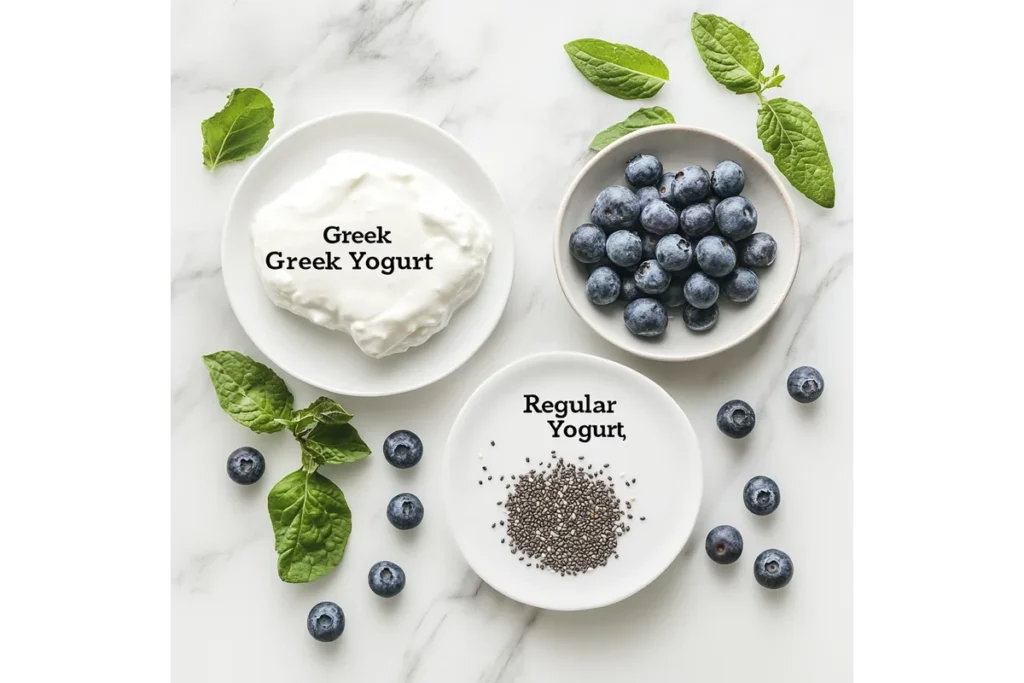What Is Yogurt?
Yogurt’s been around for ages —like, ancient Mesopotamia old. At its core, it’s milk fermented with live cultures (think Lactobacillus bulgaricus and Streptococcus thermophilus ). These bacteria munch on lactose, turning it into lactic acid, which gives yogurt that signature tang. It’s creamy, versatile, and comes in flavors from vanilla to key lime pie. Fun fact: Some cultures drink it straight; others layer it into parfaits.
What Is Greek-Yogurt ?
Greek-Yogurt is yogurt’s thicker, bolder cousin. The magic happens during production: After fermenting, it’s strained multiple times to remove whey , the liquidy byproduct. This process packs in more protein and creates that dense, spoonable texture. While traditional in Greece (hence the name!), it’s now a global fridge staple.
Why Compare Them?
Let’s be real: Labels can be confusing. One minute you’re buying “Greek” for your protein shake, the next Greek-Yogurt wondering why your muffins turned out dry. Understanding the difference between Greek-Yogurtand helps you pick the right one for your needs—whether you’re chasing health goals or perfecting a tzatziki recipe.
Table of Contents
Production Process Differences

Ingredients and Starter Cultures
Both yogurt and Greek yogurt start with the same basics: milk and live cultures. But here’s the twist—Greek-Yogurt often uses more milk upfront since straining reduces the volume later. Those live cultures (like Lactobacillus ) are the MVPs, turning lactose into lactic acid. This process gives yogurt its tang, but Greek yogurt’s thicker texture? That’s all about what happens after fermentation.
Transitional hook: While the cultures do the heavy lifting, it’s the straining step that really sets them apart.
The Straining Process
Picture this: Greek-Yogurt goes through a spa day—multiple rounds of straining to remove whey , the watery liquid leftover. Regular yogurt skips this workout, leaving it looser and lighter. Straining not only thickens Greek yogurt but also concentrates its protein and reduces carbs. Think of it like comparing a protein shake to a milkshake—same dairy family, totally different vibe.
Fun analogy: If yogurt is a cozy blanket, Greek yogurt is a weighted one—same comfort, more heft.
Fermentation Time
Fermentation time affects tanginess, but here’s a myth buster: Greek yogurt isn’t fermented longer. Both types ferment for similar durations (usually 4–12 hours). The difference? Greek yogurt’s tang often comes from the straining process, which amplifies the lactic acid flavor. So if you’re team “extra tangy,” it’s the process , not the time, that matters.
Nutritional Comparison
Calorie and Macronutrient Breakdown
Let’s get real: Greek yogurt is the protein powerhouse. A 6-ounce serving packs 15–20 grams, while regular yogurt lags at 9–12 grams. But wait—carbs tell another story. Greek yogurt has half the carbs (5–8g vs. 12–15g) thanks to whey removal. Fat content? Both come in full-fat or low-fat versions, so pick your vibe.
Greek-Yogurt High Protein Advantage

Why does protein matter? Imagine this: You’re post-workout, starving, and need a snack that sticks. Greek-yogurt got your back. Its protein keeps you full longer, making it a gym-goer’s BFF. Plus, it’s a stealthy swap for fatty ingredients—think Greek yogurt instead of mayo in tuna salad.
Pro tip: Mix it with peanut butter and berries for a killer post-run bite.
Lactose Content
Here’s the kicker: Greek-yogurt has less lactose (3–5g per serving) vs. regular yogurt (8–12g). Straining removes lactose-rich whey, so lactose-sensitive folks might tolerate Greek yogurt better. But heads up—it’s not lactose-free , so check labels if you’re super sensitive.
Texture and Taste Profiles
Creaminess and Thickness
Here’s the scoop: Greek yogurt’s texture is like a velvety hug for your mouth. Straining removes liquid whey, leaving it dense enough to hold up a spoon (okay, maybe not literally… but close). Regular yogurt? It’s more like a pourable dream—smooth and light. If you’re team “dip your chip without a mess,” Greek yogurt wins. If you’re swirling into a smoothie, regular yogurt blends like a champ.
Transitional hook: But texture isn’t the only player—flavor changes the game.
Flavor Notes
Greek yogurt’s tang is loud and proud , thanks to concentrated lactic acid from straining. It’s the Beyoncé of the yogurt world—bold, unapologetic, and perfect for savory dishes like tzatziki. Regular yogurt? Think of it as the laid-back acoustic version—milder, sweeter, and friendlier for fruit-topped breakfasts.
Foodie tip: Sweet tooths, mix Greek yogurt with honey. Spice lovers? Add garlic and dill for a killer dip.
Consumer Preferences
Let’s get real: Texture divides crowds. Some folks crave Greek yogurt’s spoonable thickness for overnight oats, while others want regular yogurt’s drinkable vibe in their morning smoothie. A buddy of mine once used Greek yogurt in muffins and ended up with “protein bricks”—lesson learned!
Culinary Uses and Substitutes
Cooking and Baking
Greek yogurt’s thickness makes it a kitchen superhero. Swap it for sour cream in tacos, mayo in chicken salad, or butter in brownies (yes, really!). Just don’t overmix—it can curdle if heated too aggressively. For lighter dishes, regular yogurt shines in dips or as a marinade base.
Smoothies and Breakfast Bowls Greek yogurt’s

Regular Greek yogurt’s thinner consistency blends seamlessly into smoothies, giving that milkshake-like texture. Greek yogurt ? It adds a protein punch but needs a splash of milk to avoid a chalky sip. For breakfast bowls, layer either with granola—but Greek yogurt holds toppings like a champ.
Recipe plug: For more ideas, check out our “5-Minute Yogurt Breakfasts” article!
Dietary Adaptations
Vegan? Both yogurts have plant-based twins. Coconut milk Greek yogurt mimics the thickness, while almond milk yogurt stays light. Just watch for added sugars—some brands sneak them in like candy.
Health Benefits and Drawbacks
Probiotic Content
Both yogurts boast gut-friendly probiotics, but here’s the scoop: The live cultures in Greek yogurt might be slightly more concentrated due to straining. These probiotics (like Lactobacillus ) help digestion and immune function. But watch out—flavored varieties often pack added sugars, which can counteract the benefits. Stick to plain versions to keep your gut (and taste buds) happy.
Transitional hook: Probiotics aside, let’s talk gym gains.
Greek Yogurt’s Role in Muscle Recovery
With 15–20g of protein per serving, Greek yogurt is a post-workout rockstar. It delivers casein and whey protein , which repair muscles fast. A buddy of mine swears by mixing it into his post-run shakes—says it’s like “giving his legs a protein hug.” Regular yogurt? At half the protein, it’s better for lighter recovery needs.
Sodium and Sugar Considerations
Here’s a curveball: Greek yogurt often has more sodium (50–100mg) than regular yogurt due to straining processes. And while both can be sugary bombs in flavored forms, Greek yogurt’s lower carb count makes it easier to sweeten yourself. Pro tip: Add mashed bananas or a drizzle of maple syrup instead of buying pre-sweetened tubs.
How to Choose the Right Option
Dietary Needs
Low-carb dieters, Greek yogurt’s your jam (just 5–8g carbs). Vegan? Try coconut-based Greek yogurt. For low-fat diets, regular yogurt’s often lighter, but check labels—some brands sneak in fillers.
Anecdote: I once tried almond milk yogurt for a dairy-free diet… and ended up eating it straight from the tub. No regrets.
Recipe Requirements
Baking a cake? Regular yogurt keeps it moist. Making tzatziki? Greek yogurt’s thickness won’t water down your cucumbers. Need a sub for sour cream? Greek yogurt’s got you covered (just add a splash of milk if too thick).
Taste Preferences
Crave tang? Go Greek. Prefer mild? Stick with regular. A friend once described Greek yogurt as “yogurt with a PhD in sass”—so if you’re all about that bold flavor, embrace the tang.
FAQs :
Is Greek yogurt healthier than regular yogurt?
It depends! Greek yogurt edges ahead in protein (double the grams) and has fewer carbs, making it ideal for low-carb diets. But regular yogurt often has more calcium and probiotics per serving. If you’re lactose-sensitive, Greek yogurt’s lower lactose might be a win. Bottom line: “Healthier” is a personal call based on your goals.
Can I substitute Greek yogurt for sour cream?
Absolutely! Its thick texture makes it a 1:1 swap in tacos, baked potatoes, or dips. Just stir in a splash of milk if it’s too dense. Pro tip: It’s healthier and cuts calories by 40%.
Why is Greek yogurt more expensive?
Straining removes liquid whey, which means more milk is needed upfront. Plus, the extra processing steps bump up the cost. Think of it as the “cold brew” of the yogurt world—more effort, higher price tag.
Does Greek yogurt contain more probiotics?
Not necessarily. Both types have live cultures, but Greek yogurt’s straining can reduce probiotic count slightly. For maximum gut benefits, look for labels with “live and active cultures” and minimal additives.
Are they both suitable for lactose intolerant people?
Greek yogurt’s lower lactose (3–5g vs. 8–12g) makes it easier to digest for some. But neither is lactose-free—try plant-based alternatives like almond or oat yogurt if dairy’s a no-go.
Conclusion :
Summary of Key Differences
Greek yogurt = thick, high-protein, low-carb. Regular yogurt = creamy, higher calcium, lighter texture. The difference between yogurt and Greek yogurt boils down to straining, nutrition, and how you use ’em.
Final Recommendations
Need a workout buddy? Grab Greek yogurt. Baking a cake? Regular’s your gal. Love tangy dips? Go Greek. Crave fruity parfaits? Regular’s creaminess shines.
Future Trends
Plant-based versions (like cashew or pea protein yogurt) are blowing up—perfect for vegan diets. And with trends leaning toward high-protein snacks, Greek yogurt’s throne is safe… for now.
Last call: Keep experimenting! Mix both yogurts in smoothies, swap them in recipes, and find your perfect match. Your fridge (and gut) will thank you.
For more delicious recipes and kitchen inspiration, stick around and explore our other articles.
Print
Difference Between Yogurt and Greek Yogurt: 5 Key Benefits
- Total Time: 5 minutes
- Yield: 1 serving (adjust quantities for more servings) 1x
- Diet: Vegan
Description
Discover a variety of healthy and delicious Greek yogurt recipes that cater to every meal of the day. From creamy breakfast parfaits to savory main courses and guilt-free desserts, these ideas are easy to make, nutrient-packed, and perfect for any diet
Ingredients
- 1 cup plain Greek yogurt (unsweetened)
- ½ cup granola (low-sugar preferred)
- ½ cup mixed fresh berries (strawberries, blueberries, raspberries)
- 1 tablespoon honey or maple syrup (optional)
- 1 teaspoon chia seeds or flaxseeds (optional for added nutrition)
Instructions
- Start by spooning a layer of Greek yogurt into a bowl or glass.
- Add a layer of granola on top of the yogurt for crunch.
- Arrange fresh berries over the granola.
- Drizzle with honey or maple syrup if you want a touch of sweetness.
- Sprinkle chia seeds or flaxseeds for an extra nutrient boost.
- Repeat the layers until the serving is complete. Serve immediately or chill for later.
Notes
- For a vegan option, substitute Greek yogurt with coconut or almond-based yogurt.
- Adjust sweetness based on your preference—use ripe fruit for natural sugars.
- Prep ingredients ahead of time for quick assembly during busy mornings.
- Prep Time: 5 minutes
- Cook Time: 0 minutes (No cooking required)
- Category: Breakfast, Snack, Healthy Eating
- Method: No-cook, Assembly
- Cuisine: International (Versatile for all cuisines)
Nutrition
- Serving Size: 1 parfait (approximately 1 cup)
- Calories: 250kcal
- Sugar: 15 g (varies based on toppings)
- Sodium: 80 mg
- Fat: 8 g
- Saturated Fat: 2 g
- Unsaturated Fat: 5 g
- Trans Fat: 0g
- Carbohydrates: 30 g
- Fiber: 4 g
- Protein: 15 g
- Cholesterol: 10 mg
Keywords: difference between yogurt and Greek yogurt

